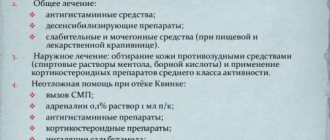Causes of urticaria
The disease occurs under the influence of histamine and some other substances secreted by special “mast” cells of the skin. Histamine increases vascular permeability, causing swelling, and acts on nerve endings, leading to a burning sensation and itching. The main causes of urticaria are associated with disturbances in the functioning of the immune system. She begins to react inadequately to ordinary stimuli that would not cause any symptoms in a healthy person. It can be:
- food products;
- infections;
- medicines;
- food colorings;
- preservatives;
- insect bites.
Often the cause of the disease remains unknown (idiopathic urticaria). This disease is not contagious, but the tendency to it is inherited. Hives may disappear with age. Doctors believe that nervous urticaria without the influence of other factors is extremely rare; rather, on the contrary, its presence causes stress and anxiety in a person.
Classification of the disease
There are two forms of urticaria:
- acute (duration is about 6 weeks),
- chronic (over 6 weeks).
- There are different types of immunological urticaria:
- Urticarial vasculitis.
- Allergic
- Compliment addict.
- Autoimmune.
- Physical is divided into:
- mechanical: vibration, dermographic;
- temperature: thermal or cold contact;
- allergies that develop under the influence of other extraneous factors.
- There are also the following forms of urticaria:
- Contact.
- Aquagenic.
- Adrenergic.
- Idiopathic.
- Urticaria caused by non-IgE-mediated mast cell degranulation.
- Cholinergic.
- Drug-induced urticaria with development mechanisms different from those previously described.
Types of urticaria
Depending on the time of existence of the rash, the disease occurs in two forms:
- acute urticaria, which resolves spontaneously in less than 8 weeks, and under the influence of medications - within a few hours;
- chronic urticaria, which can be a symptom of a serious illness and exists without changes for more than 8 weeks; in this case, a generalized rash on the body is possible.
Depending on the predominant mechanism of development of the pathology, several types of urticaria can be distinguished:
- Allergic urticaria appears in response to an allergen entering the body (not necessarily on the skin, most often inside), for example, a food product (strawberries, citrus fruits, seafood and many others) or medications.
- Cholinergic urticaria occurs under the influence not of histamine, but of acetylcholine, secreted by skin cells in response to high temperature, load, stress, and mechanical factors.
- Cold urticaria occurs when the skin is exposed to cold air, dampness, or wind.
- Solar urticaria is associated with an abnormal reaction of the skin to ultraviolet radiation and usually occurs on exposed areas of the skin.
- Urticaria pigmentosa is a special form of the disease that most often occurs in young children and is accompanied not only by rashes, but also by darkening of areas of the epidermis as a result of the accumulation of melanin in them. Another name for the disease is cutaneous mastocytosis.
In approximately half of the cases, patients with any type of pathology experience autoimmune urticaria, which is associated with the appearance of antibodies to the cells of the immune system in the body. When exposed to an allergic factor, these antibodies quickly interact with receptors on the membranes of these cells, leading to the release of histamine. This condition is usually genetically determined. In other cases of the disease, the autoimmune component cannot be determined. Thus, there is currently no treatment method aimed at the cause of the disease, and therapy is carried out mainly symptomatically.
3. Diagnosis of rashes
Idiopathic urticaria can only be diagnosed by an allergist.
.
To do this, he prescribes a series of examinations, the purpose of which is to identify the connection of skin manifestations with specific factors and causes, the elimination of which could prevent the development or exacerbation of urticaria. The patient undergoes the following tests:
- general clinical blood test;
- biochemistry;
- HIV testing;
- blood for the Wasserman reaction;
- general urine analysis;
- blood and feces to identify parasites and helminths.
An important diagnostic step is a conversation with the patient
, during which the possible dependence of skin rashes on food, chemicals, stress, heredity, and medications taken is clarified.
Sometimes it is recommended to keep a symptomatic diary
, where each exacerbation of urticaria is recorded. In this case, the patient should try to remember any previous factors that could affect the state of the body, and also write them down. Sometimes only such records allow us to trace a certain pattern.
If a significant period of careful observation does not give a clear picture, there are no chronic diseases and exacerbations are unsystematic, then a diagnosis of “idiopathic allergy” is made.
About our clinic Chistye Prudy metro station Medintercom page!
Diagnosis of urticaria and its manifestations
Recognition of the disease is based on its external signs. Urticaria is characterized by rashes in the form of blisters, reminiscent of a nettle burn or lemon peel (the rarer common name for the rash is lemongrass). They are able to quickly change size, disappear and appear on new areas of the skin within a few hours. Typically, an attack of the disease lasts about a day, accompanied by redness and swelling of the skin, itching, general weakness, headache, and increased body temperature.
A more severe form of the disease, manifested by swelling of the limbs, lips, eyelids, and neck, is called angioedema (Quincke's edema). This condition occurs very quickly as an allergy to a medicine or an insect bite and is life-threatening as it can cause suffocation.
The examination includes a general blood test; less often, it is necessary to determine general and specific immunoglobulin E, a laboratory sign of allergy that allows one to determine its nature. Sometimes allergy skin tests are performed to identify the allergen.
Doctors also need to exclude helminthic infestations, for example, opisthorchiasis, and identify foci of chronic infection (caries, tonsillitis, sinusitis and others). The network of family clinics “Mama Papa Ya” offers a comprehensive examination by specialists in various fields to diagnose the disease and individually select therapy.
Symptoms
What are the main signs of a nettle rash?
- Skin redness
- The appearance of blisters
- Weakness
- Dizziness
- Itchy skin
- Joint pain
- Temperature increase
- Nausea
- Vomit
- Chills
- Diarrhea
- Insomnia
- Swelling of the skin and mucous membranes.
Urticaria is one of the most common diseases. In general, the definition refers to a number of individual ailments, characterized by different specific natures of occurrence, but manifesting themselves in the same way.
Make an appointment online
Sign up
Prevention and treatment of urticaria
Treatment of allergic urticaria is carried out using a set of methods:
- following a hypoallergenic diet or eliminating a product or medication that provokes an attack of the disease;
- use of hypoallergenic detergents and cosmetics in everyday life, caution when taking antibiotics and vitamins;
- to quickly relieve an episode of rash, use antihistamines internally (in the form of tablets) and externally (in the form of gels and ointments that relieve itching);
- for more severe manifestations, the administration of glucocorticoids and the use of hormonal ointments is indicated;
- During treatment, it is recommended to consume large amounts of fluid and intestinal sorbents to help remove the allergen from the gastrointestinal tract;
- Additionally, you can take sedatives.
It is better to entrust the correct choice of therapy and prescribe modern, effective and safe medications to a doctor - a dermatologist or allergist.
To prevent the recurrence of urticaria, it is necessary to avoid the action of the provoking factor. It is also not recommended to wear thick synthetic clothing or stay in damp places.
ethnoscience
Treatment with traditional medicine
To eliminate the unpleasant symptoms of the disease, traditional medicine offers:
- For severe rashes, take soda baths twice a day for half an hour or wipe the body with vinegar water.
- Taking mint infusion three times a day has a calming effect.
- Nervous urticaria can be treated with nettles. It is brewed, infused as tea, filtered and added to a bath with diluted soda. If you have a high-quality solution, you won’t have to wait long for results. All blisters disappear for a long time.
- Infusion of 200 g of marjoram per 2 liters of boiling water. Used for baths to relieve unpleasant rashes.
- Compresses with celery juice effectively combat the manifestations of urticaria.
- Bean broth (20 g per liter) is used as a skin tonic. Used as compresses or baths.
- A decoction of duckweed (1 tablespoon of crushed seaweed is infused in 100 ml of boiling water for ten minutes and drunk immediately).
Treatment of the disease at the Mama Papa Ya clinic
Clinic "Mama Papa Ya" is located in Lyubertsy. Here we see qualified doctors of various specialties who will provide assistance to patients with urticaria:
- in the clinic you can do the necessary tests and undergo the necessary examination;
- can be treated for both adults and children;
- consultations with specialists in various fields provide the most complete treatment for urticaria;
- We offer affordable prices for medical services and convenient work hours.
To make an appointment, call the phone number listed on the website or through the form provided.
Reviews
Good clinic, good doctor!
Raisa Vasilievna can clearly and clearly explain what the problem is. If something is wrong, she speaks about everything directly, not in a veiled way, as other doctors sometimes do. I don’t regret that I ended up with her. Anna
I would like to express my gratitude to the staff of the clinic: Mom, Dad, and me. The clinic has a very friendly atmosphere, a very friendly and cheerful team and highly qualified specialists. Thank you very much! I wish your clinic prosperity.
Anonymous user
Today I had a mole removed on my face from dermatologist I.A. Kodareva. The doctor is very neat! Correct! Thanks a lot! Administrator Yulia Borshchevskaya is friendly and accurately fulfills her duties.
Belova E.M.
Today I was treated at the clinic, I was satisfied with the staff, as well as the gynecologist. Everyone treats patients with respect and attention. Many thanks to them and continued prosperity.
Anonymous user
The Mama Papa Ya clinic in Lyubertsy is very good. The team is friendly and responsive. I recommend this clinic to all my friends. Thanks to all doctors and administrators. I wish the clinic prosperity and many adequate clients.
Iratyev V.V.
We visited the “Mama Papa Ya” Clinic with our child. A consultation with a pediatric cardiologist was needed. I liked the clinic. Good service, doctors. There was no queue, everything was the same price.
Evgeniya
I liked the first visit. They examined me carefully, prescribed additional examinations, and gave me good recommendations. I will continue treatment further; I liked the conditions at the clinic.
Christina
The doctor carefully examined my husband, prescribed an ECG and made a preliminary diagnosis. She gave recommendations on our situation and ordered additional examination. No comments so far. Financial agreements have been met.
Marina Petrovna
I really liked the clinic. Helpful staff. I had an appointment with gynecologist E.A. Mikhailova. I was satisfied, there are more such doctors. Thank you!!!
Olga
{loadmodule formrec}
Diagnostic search
The diagnostic search for neurogenic urticaria is aimed at finding out the cause of the disease. This will allow for targeted treatment and, if possible, prevent the development of another exacerbation.
Diagnostics includes the following research methods:
- General clinical blood test.
- Immunological study to determine the state of immunity.
- Determination of the level of class E immunoglobulins in the blood.
- Allergy skin tests.
- Consultation with a neurologist and, if indicated, a psychiatrist.
- Electroencephalography.
- Computed tomography of the brain and some others.
Treatment of nerve rash on the body
Treatment for rashes is similar for all types
First, it is very important to consult a neurologist and dermatologist to prescribe a comprehensive treatment. Regardless of the type of nervous rash, treatment should consist of an external and psycho-emotional component
Since the rash is most often accompanied by itching, the patient is prescribed antihistamines, for example, Cetrin, Diazolin. Vitamins are also prescribed to strengthen the overall immune system. The products “Bepanten” and “Fenistil” heal the skin, but they cannot be used without a doctor’s prescription.
The psychotherapist may prescribe herbal sedatives. They relieve tension well and help you relax. If necessary, the patient undergoes a course with a psychologist to help understand what caused the stress. If these methods do not help, antidepressants and sedatives are prescribed. They recommend a change of scenery and a good rest.
For nervous scabies, Hydrocortisone and Photocort are used to eliminate itching and irritation. They must be used strictly according to a doctor's prescription. For all types of rashes, you need to normalize your diet and avoid spicy, seasoned foods. Do not wear synthetic clothing. All these measures taken together should help eliminate the rash in a couple of weeks.









